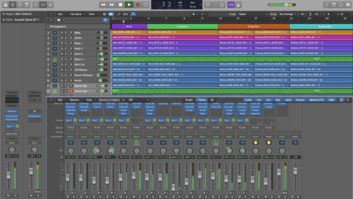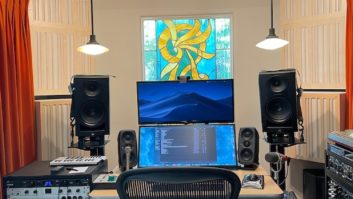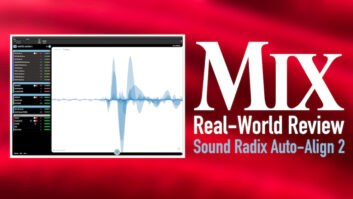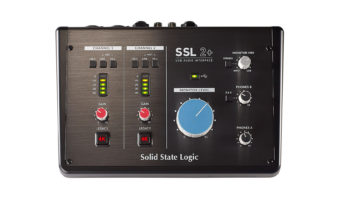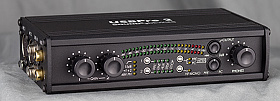
The USBPre 2 offers numerous I/O options and records at up to 192 kHz.
About 10 years ago, Sound Devices released the USBPre. It offered a multitude of I/O options and clean mic/line gain. The sequel, USBPre 2, is as new and improved as you’d expect, but sells itself short in its name. It’s more than a USB mic preamp, offering some of the most flexible I/O options you’ll find on an interface this size. It’s also built like a tank and is the perfect back-pocket tool to bring to any gig.
The physical connectivity is impressive. There are a pair of XLR mic inputs, a pair of ¼-inch TRS line-level inputs, a pair of unbalanced RCA inputs, a dedicated RCA coaxial S/PDIF input and a Toslink S/PDIF input. Outputs are also deluxe: a pair of male XLR connectors that will output mic or line-level; individually selectable, unbalanced RCA outs; S/PDIF outputs on RCA or Toslink; and headphone outputs including a ¼-inch TRS and a 3.5mm mini-headphone jack. Computer connectivity is handled through a USB 2 B-Type connector. With all of these I/O options, combined with an array of DIP switches to toggle available signal flows, the possible functions of this device are incredible.
VERSATILITY DEFINED
The USBPre2 is quick on its feet. It can be used as a stand-alone preamp, A/D converter, D/A converter or monitoring interface for a computer. Many of these components can be chained together in any desired combination. Considering its potential use as a portable front end for another device, aside from a computer, you may share one of my original concerns: The device can only be powered from a USB connection. After becoming aware of the wide world of wall-wart-style power supplies that terminate to a USB connection, this concern was erased. For portable use away from a computer, a representative from Sound Devices turned my attention toward the Energizer Energi to Go XP8000 Power Pack, a rechargeable battery pack that he had used to power the USBPre 2 successfully.
I tested the USBPre 2 in a variety of workflows, first as a simple back end for computer monitoring. The headphone amp provided generous gain, which is accessible through a clean, sturdy control knob. The sound of the D/A conversion clocked internally was widely dynamic, open in frequency response and remarkably clean. The top end sounded soft and natural, the midrange free of congestion, and the bottom end round and full. All of these qualities were well complemented by a tastefully engineered headphone amp, but also translated to a vivid stereo image when fed through the line outputs to a pair of active monitors.
I tried out the front end of the USBPre 2 both as a stand-alone pre and as an interface feeding Pro Tools 9. I used the preamps to record Foley and ADR, relying on an Avid Pro Tools HD 96 I/0 for conversion. In this case, I would have appreciated a dedicated BNC word clock input so I could have simply taken a tap off of the same master clock that was feeding my Pro Tools SYNC | HD and video machine, and fed S/PDIF out of the USBPre 2 to the 96 I/O. Granted, clocking through the USBPre 2’s S/PDIF input may have been a possibility, but with all of the other connections considered, a dedicated word clock input doesn’t seem outside the realm of expectations.
That aside, the preamp performed impressively, providing a well-detailed recording without excessively coloring the output of the microphone. The sound was full throughout the lower ranges, never brittle, and free of any noticeable hum. In fact, I was somewhat surprised to notice how low the preamp’s noise floor was. Upon further investigation, I heard the noise change with each microphone selection and arrived at the conclusion that the self-noise of the microphones exceeded the noise of the USBPre 2 itself. Using a TLM 103 (a microphone known for low self-noise) in a quiet room, I had to crank the mic into distortion before any noticeable hiss or noise could become apparent. According to the Sound Devices Website, on the topic of the USBPre 2’s microphone preamps, “Their topology is shared with Sound Devices award-winning 744T digital audio recorder,” which is well known as an industry standard in field recording.
ABLE DAW COMPANION
Using the USBPre 2 as a Pro Tools 9 interface provided a pleasant experience all around. I was equally impressed with the A/D converters as I was the D/A converters. Again, recorded sounds were detailed and smooth at the top end. The conversion was accurate and lacked the garbled phase discrepancies often found when using portable USB interfaces. A physical analog control allowing the blending of input signals with output from computer allowed a means to A/B the signal pre- and post-conversion—the two sounds were strikingly similar. Sample rates are available from 44.1 kHz through 192 kHz for recording and playback at 16 or 24 bits per sample. Recording or playback are selectively metered with an onboard peak meter. Each channel, left and right, is segmented into 24 LED segments displaying values from 0 dBFS down to -44 dBFS. This proved very useful, as accurate input or output metering (toggled with a convenient button on the front panel) was achievable even in poor lighting conditions.
The USBPre 2’s build quality is quite impressive. All connectors and knobs are sturdy and feel very solid. Two smaller front panel knobs (main output level and the pre/post-monitoring knob) pop up or recess into the unit to keep them safe during transit. All of the front panel buttons are tiny, sturdy metal toggles, rounded on the top, that sit low enough to prevent bumping or snagging. Additional functions like highpass filtering, phantom power and various other options are provided using DIP switches to toggle their functions. Though slightly less convenient than some alternatives, the tradeoff is that they’re safely housed beneath a rubber dust-cover. Moreover, other devices would rely on a software control panel to make selections provided here with controls on the hardware unit itself. Thus, there is no software to install, no drivers, no control panel or anything else. Plug it in, and it works.
THIS IS A BUY
The USBPre 2 is one of the most practical and convenient portable USB interfaces available. It offers great-sounding analog circuits, impressive clocking and conversion, and a generous selection of I/O combinations. It provides clean, honest recorded sounds via its onboard pre’s, or gives you clean A/D conversion if you connect a more flavorful preamp. Likewise, it provides clear and detailed monitoring with a headphone amp that will never fall short on gain. And while I assumed it would price out just a bit more than $1,000, the price tag is a far more reasonable at $650 street. If you’re looking for a stepped-up portable interface, this would be an excellent pick.
Brandon Hickey is an engineer and educator who likes hoppy beer and the Blackhawks.

Click on the Product Summary box above to view the USBPre2 product page.



